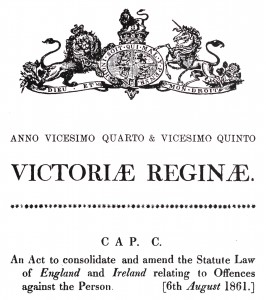What is the person in offences against the person? And what is it to be protected from? The answers might seem to be fairly obvious, but as with many questions in the criminal law once you start to look more closely things can get more complex.
We can see some of the issues in this area by looking at the history and interpretation of the Offences Against the Person Act 1861. Here, in addition to the provisions in sections 18, 20 and 47 relating to forms of interpersonal violence which are well known to contemporary criminal lawyers, the Act contains provisions which are very specific in their definitions and identify particular ways of causing harms to others. Thus there are offences relating to the use of chloroform to commit another indictable offence (s.22), the administration of poison or other noxious substances (ss.23 & 24), causing danger on railways (ss.32-4), wanton and furious driving (s.35) and so on. The Act also recognised different degrees and types of harms as being relevant to the form of liability. On the one hand, we see this in the category of grievous bodily harm (ss.18 & 20), as opposed to (actual) bodily harm (s.47). On the other, we see it in a range of offences that criminalise assault with intent to do other crimes or which endanger life in some way (ss.21-2, 26, 27, 29-34 & 38-9). And there are still other offences which related to the status of the victim, such as assaulting a clergyman, or a magistrate or officer of the peace (ss.36-40).
While some of these offences look anachronistic and over-particular to the modern eye, the codification of criminal conducts in the 1861 Act (and its predecessors) represent an important shift in ways of thinking about interpersonal violence and the kinds of objects that were to be protected. One important shift was the extension of modes of commission. The law traditionally was concerned only with forms of direct interpersonal violence against another person who was in the immediate vicinity of the aggressor. However, the Act recognises a much wider range of modes of causing harm to or interfering with another person. This is graphically captured in certain nineteenth-century statutes, such as Lord Ellenborough’s Act 1803, the long title of which listed the following objects, amongst other things: An Act for the further Prevention of malicious shooting, and attempting to discharge loaded Fire-Arms, stabbing, cutting, wounding, poisoning, and the malicious using of Means to procure the Miscarriage of Women. This opens up the possibility of imposing liability for action at a distance, that is to say actions that bring about consequences in a different place or at a later point in time – often as a consequence of technological development. This is dramatically illustrated by a recent English case in which liability was imposed for the making of silent phone calls which caused psychic harm where there was no suggestion that the defendant was in the proximity of the victim.
Overall these changes reflect a transformation of the sphere of personhood. The object of law of assault was originally the protection of the body, but this has come to be understood as extending to a fuller sense of personhood, understood as a kind of personal space in which an individual is able to exercise or develop their autonomy and sense of self. Recent developments in English law, for example, have seen the protection of the person against ‘psychic harm’ as well as the protection of forms of racial and religious identity in the limited recognition of ‘hate crimes’. This is also linked to the transformation of agency. The consequences of actions are seen as extending further through time, and so the actor is correspondingly expected to anticipate and guard against the possible consequences of their actions on the phyical and psychic wellbeing of others.As with developments in other areas of the law this suggests that the development of the law of offences against the person is complex and uneven, but with a gradual shift towards the expansion of liability.
This is a blog about the history, theory and practice of the criminal law. I shall write about books, cases, trials, novels that catch my interest, and even occasionally about current events. My aim is not comment on current caselaw or issues in criminal justice, but to rather to develop a more oblique critique of the law.
Oblique intent
Why the name? Well criminal law afficionados will recognise the phrase 'oblique intent' as referring to a problem of mens rea:can a person who intends to do x (such as setting fire to a building to scare the occupants) also be said to have an intention to kill if one of the occupants dies? This is a problem that has consumed an inordinate amount of time in the appeal courts and in the legal journals, and can be taken to represent a certain kind of approach to legal theory. My approach is intended to be more oblique to this mainstream approach, and thus to raise different kinds of questions and issues. Hence the name.


No comments:
Post a Comment